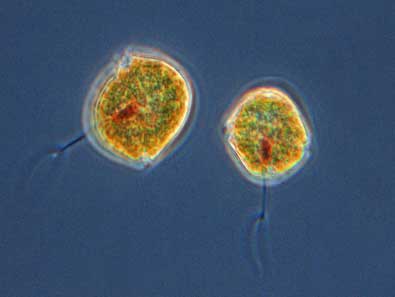Phytoplankton are microscopic, plant-like organisms that live in the ocean. Unlike macroalgae like seaweed that you can easily see lying on the beach, it is difficult to see microalgae or phytoplankton without a microscope.
Diatoms and Dinoflagellates
There are many types of phytoplankton, but the two most common are diatoms and dinoflagellates.
- Diatoms are single-celled algae that have chloroplasts and can undergo photosynthesis.
- Dinoflagellates are also single-celled but they have two whip-like tails called “flagella.” Although many dinoflagellates also have chloroplasts, not all do.
Both types of phytoplankton can be autotrophic and use photosynthesis to harvest the sunlight to produce their own energy, but some dinoflagellates are heterotrophic and rely on eating other organisms for energy; as far as we know, there are no heterotrophic diatoms.
Phytoplankton are the primary producers in the food web — similar to the grasses and trees found on land. They help to provide food and energy for zooplankton, krill, and abalone that in turn feed the birds, whales and even humans.
Glossary Terms
Chloroplast: A specialized structure in a cell with photosynthetic pigments.
Photosynthesis: The process of using the sun’s energy to convert carbon dioxide and water into carbohydrates and oxygen; carried out by green plants, algae and cyanobacteria.
Autotrophic: Describes an organism that makes organic material from inorganic material; a primary producer. Examples include plants, phytoplankton and some bacteria.
Heterotrophic: An organism that obtains its organic matter from the environment (usually from autotrophs); a consumer.
Primary producer: An organism that makes organic material from inorganic material; an autotroph. Examples include plants, phytoplankton, and some bacteria

